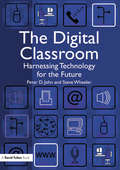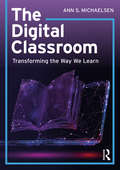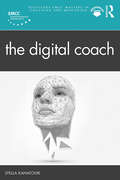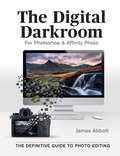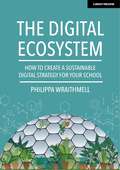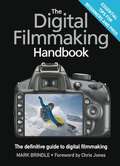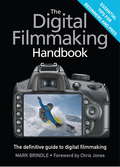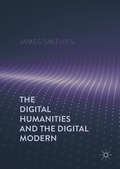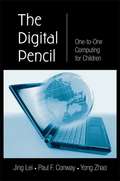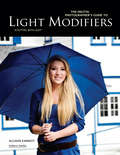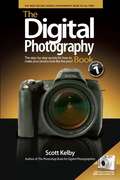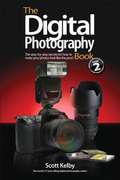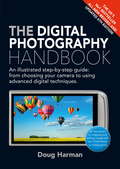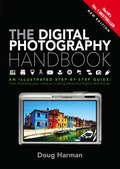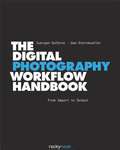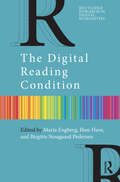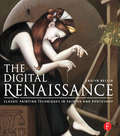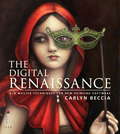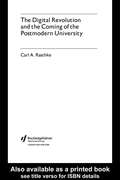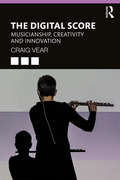- Table View
- List View
The Digital Classroom: Harnessing Technology for the Future of Learning and Teaching
by Peter John Steve WheelerBased on a major research project (the InterActive Project), this book explores and illustrates how digital technologies can transform learning across the curriculum. Using a wide range of educational settings – primary, secondary, school and home – it will help practitioners think about, plan and execute effective learning in their classrooms and beyond. It will show teachers how they can 'harness technology for the future' by covering important topics such as: personalised learning using ICT for pupils with special needs personal use of ICT and home-school links designing 'digital' classrooms. By weaving 'evidence based practice' into each chapter, the book will provide extensive guidance, practical advice and insights into working in the 'digital classroom' for all primary and secondary school teachers.
The Digital Classroom: Transforming the Way We Learn
by Ann S. MichaelsenThe way students learn changes when they have access to digital tools. The Digital Classroom demonstrates that using technology to enhance students’ learning is not dependent on a specific learning management system or software – it is about changing the pedagogy with the help of an arsenal of useful tools and methods. This practical book introduces easy to use methods to all teachers in digital classrooms with the intention to make it simple, accessible, and achievable for everyone. It is not only about the tools, and the how and why, but also about changing the pedagogy making the learning more relevant to the students. When you open the classroom to the rest of the world, the teacher becomes more important than ever. Topics in the book include: Technology and deeper learning Social media in the global classroom Building a personal learning network The flipped classroom and cooperative learning The use of iPads in primary and middle school Teaching with videogames Special education Digital citizenship Digital tools can play a key role in making learning happen and what the teachers know about the use of technology is key. The Digital Classroom will be of great interest to teachers and trainee teachers who wish to develop their digital competency by using the book as part of their professional learning.
The Digital Coach (Routledge EMCC Masters in Coaching and Mentoring)
by Stella KanatouriThanks to digital media, coaching doesn´t have to be constrained by geographical and temporal boundaries. Using digital media to facilitate coaching processes however, creates a distinct form of coaching practice that requires additional skill from the coach. The Digital Coach contains insights based on a comprehensive, exploratory research that analysed the discussions of a 1,000 member strong online community of coaches and several interviews with coaches to understand their practical experiences of working with technology. At the same time, the book offers information, insights, and examples that can be readily used by the coaching practitioner. Based on the developments in the field, the book provides suggestions about improving the usability of coaching software, and it offers reflections on how emerging technologies like immersive Virtual Reality, Augmented Reality, and Artificial Intelligence might extend coaching practice. Whilst acknowledging the limitations and potential risks that may arise by integrating digital media in coaching, the book suggests that coaching success doesn’t only depend on media capabilities, but also on the coach. The digital coach develops enhanced coaching skills and adapts coaching practice to the media in use. The book is dedicated to the coaching practitioner who uses digital media or who is considering doing so, and is relevant for coaching supervisors, buyers of coaching services, human resource professionals, and software designers.
The Digital Darkroom: The Definitive Guide to Photo Editing
by James AbbottPost-production can make the difference between a good image and a great image, not to mention it's an essential process if you shoot in RAW to enjoy the most flexibility and control possible. This book will outline everything you need to know to gain a better understanding of how to apply darkroom style effects to your images using Adobe Photoshop and Affinity Photo.Through detailed background knowledge designed to make you familiar with the software and to build your confidence, you'll learn a wide range of skills and techniques through step-by-step case studies that will make learning an active experience. Not only will this be a valuable reference resource, it will also be your very own personal tutor giving you everything you need to edit your images like a pro. - Learn the essentials with a complete guide to every tool, filter and effect for both Adobe Photoshop and Affinity Photo- Get the most out of your RAW files with detailed instructions on processing your digital image- Master basic, intermediate, and advanced editing techniques with easy to follow step-by-step tutorials- Get the best quality images for display with a complete guide to home printing
The Digital Darkroom: The Definitive Guide to Photo Editing
by James AbbottPost-production can make the difference between a good image and a great image, not to mention it's an essential process if you shoot in RAW to enjoy the most flexibility and control possible. This book will outline everything you need to know to gain a better understanding of how to apply darkroom style effects to your images using Adobe Photoshop and Affinity Photo.Through detailed background knowledge designed to make you familiar with the software and to build your confidence, you'll learn a wide range of skills and techniques through step-by-step case studies that will make learning an active experience. Not only will this be a valuable reference resource, it will also be your very own personal tutor giving you everything you need to edit your images like a pro. - Learn the essentials with a complete guide to every tool, filter and effect for both Adobe Photoshop and Affinity Photo- Get the most out of your RAW files with detailed instructions on processing your digital image- Master basic, intermediate, and advanced editing techniques with easy to follow step-by-step tutorials- Get the best quality images for display with a complete guide to home printing
The Digital Ecosystem: How to create a sustainable digital strategy for your school
by Philippa WraithmellThe Digital Ecosystem will take you on a journey to develop your own sustainable digital strategy – one that is right for your school and yours alone, acknowledging that every school is different, just like every child. Covering all elements in order to blend your school's core values and ethos with the reality of today's digital world, this book will take you through building your digital governance, tightening up on your safeguarding in our changing digital world and supporting you to have the confidence to build on and develop your digital pedagogy and systems. With insights from schools globally into all areas of the digital ecosystem, the book intends to inspire and allow you to develop your own digital vision.
The Digital Ecosystem: How to create a sustainable digital strategy for your school
by Philippa WraithmellThe Digital Ecosystem will take you on a journey to develop your own sustainable digital strategy – one that is right for your school and yours alone, acknowledging that every school is different, just like every child. Covering all elements in order to blend your school's core values and ethos with the reality of today's digital world, this book will take you through building your digital governance, tightening up on your safeguarding in our changing digital world and supporting you to have the confidence to build on and develop your digital pedagogy and systems. With insights from schools globally into all areas of the digital ecosystem, the book intends to inspire and allow you to develop your own digital vision.
The Digital Filmmaking Handbook
by Chris Jones Mark BrindlePart of the perennially best-selling Quercus Digital Photography series, this comprehensive guide features everything you need to know to make a digital film, from conception to finished product. Using clear, step-by-step instruction, The Digital Filmmaking Handbook concisely illustrates the technical and creative challenges of digital filmmaking for novices and professionals alike, spanning topics from conception to execution: - Planning a shoot: how to make a storyboard - Set preparation: dressing and lighting a set - Principal photography: filming with HD and DSLR cameras--including the latest advice on equipment, accessories, and software - Advanced editing: software and practices - Post-production: digital effects and Packed with tips and tricks to develop both your creative vision and your technical know-how, The Digital Filmmaking Handbook is the ultimate resource for all your filmmaking needs. From the Trade Paperback edition.
The Digital Filmmaking Handbook
by Mark BrindleWhether you are already a seasoned director or simply a film fan, this comprehensive guide features everything you need to know to make a digital film: from the basics of capturing footage and planning a shoot, to the more advanced aspects of editing and post-production. Clear, step-by-step instruction on the technical aspects of filming with HD and DSLR cameras - including the latest advice on equipment, accessories, and software - are set alongside tips on the creative aspects - such as effects, making a storyboard and creating and lighting a set. Packed with tips and tricks to develop both your artistic flair and your technical know-how, The Digital Filmmaking Handbook is the ultimate resource for all your filmmaking needs.
The Digital Filmmaking Handbook
by Mark BrindleWhether you are already a seasoned director or simply a film fan, this comprehensive guide features everything you need to know to make a digital film: from the basics of capturing footage and planning a shoot, to the more advanced aspects of editing and post-production. Clear, step-by-step instruction on the technical aspects of filming with HD and DSLR cameras - including the latest advice on equipment, accessories, and software - are set alongside tips on the creative aspects - such as effects, making a storyboard and creating and lighting a set. Packed with tips and tricks to develop both your artistic flair and your technical know-how, The Digital Filmmaking Handbook is the ultimate resource for all your filmmaking needs.
The Digital Humanities
by Gardiner, Eileen and Musto, Ronald G. Eileen Gardiner Ronald G. MustoThe Digital Humanities is a comprehensive introduction and practical guide to how humanists use the digital to conduct research, organize materials, analyze, and publish findings. It summarizes the turn toward the digital that is reinventing every aspect of the humanities among scholars, libraries, publishers, administrators, and the public. Beginning with some definitions and a brief historical survey of the humanities, the book examines how humanists work, what they study, and how humanists and their research have been impacted by the digital and how, in turn, they shape it. It surveys digital humanities tools and their functions, the digital humanists' environments, and the outcomes and reception of their work. The book pays particular attention to both theoretical underpinnings and practical considerations for embarking on digital humanities projects. It places the digital humanities firmly within the historical traditions of the humanities and in the contexts of current academic and scholarly life.
The Digital Humanities and the Digital Modern
by James SmithiesThis book provides new critical and methodological approaches to digital humanities, intended to guide technical development as well as critical analysis. Informed by the history of technology and culture and new perspectives on modernity, Smithies grounds his claims in the engineered nature of computing devices and their complex entanglement with our communities, our scholarly traditions, and our sense of self. The distorting mentalit#65533; of the digital modern informs our attitudes to computers and computationally intensive research, leading scholars to reject articulations of meaning that admit the interdependence of humans and the complex socio-technological systems we are embedded in. By framing digital humanities with the digital modern, researchers can rebuild our relationship to technical development, and seek perspectives that unite practical and critical activity. This requires close attention to the cyber-infrastructures that inform our research, the software-intensive methods that are producing new knowledge, and the ethical issues implicit in the production of digital humanities tools and methods. The book will be of interest to anyone interested in the intersection of technology with humanities research, and the future of digital humanities.
The Digital Pencil: One-to-One Computing for Children
by Jing LeiThis book takes a serious historical and international look at the "digital pencil" movement to equip every student with a computing device with wireless connection. Using an ecological perspective as an overarching framework, and drawing on their own studies and available literature that illuminate the issues related to one-to-one computing, the a
The Digital Photographer's Guide to Light Modifiers
by Allison EarnestFocusing exclusively on light modifiers and making the most of the least equipment, this in-depth handbook is ideal for use by the beginner and advanced amateurs who wish to take their photography to the next level. Including diagrams and lighting set scenes to facilitate learning and adapting technique, step-by-step critiques of several portrait sessions, and an extensive review of a variety of light modifying tools#151;from barn doors and snoots to gels, umbrellas, and strip boxes#151;this invaluable textbook style book reveals the precise steps for obtaining dimension and depth for indoor and outdoor portrait sessions. This resource is a must-have for beginner photographers looking to discover a treasure trove of fresh, creative lighting inspiration, that will surely help add diversity and creative style to your photography
The Digital Photographer's Guide to Light Modifiers
by Allison EarnestFocusing exclusively on light modifiers and making the most of the least equipment, this in-depth handbook is ideal for use by the beginner and advanced amateurs who wish to take their photography to the next level. Including diagrams and lighting set scenes to facilitate learning and adapting technique, step-by-step critiques of several portrait sessions, and an extensive review of a variety of light modifying tools-from barn doors and snoots to gels, umbrellas, and strip boxes-this invaluable textbook style book reveals the precise steps for obtaining dimension and depth for indoor and outdoor portrait sessions. This resource is a must-have for beginner photographers looking to discover a treasure trove of fresh, creative lighting inspiration, that will surely help add diversity and creative style to your photography
The Digital Photography Book, Volume 1: The Step-by-Step Secrets for How to Make Your Photos Look Like the Pros
by Scott KelbyThis text tackles the most important side of digital photography - how to take professional-quality shots using the same tricks today's top digital pros use.
The Digital Photography Book, Volume 2: The Step-by-Step Secrets for How to Make Your Photos Look Like the Pros
by Scott KelbyThis text tackles the most important side of digital photography - how to take professional-quality shots using the same tricks today's top digital pros.
The Digital Photography Handbook: An Illustrated Step-by-step Guide
by Doug HarmanNeed to know which digital camera to buy? Want to take better photographs and retouch images? Ready to achieve professional results? This updated edition of The Digital Photography Handbook will allow you to make the most of all the advantages your camera has to offer - as well as guiding you through the latest software to enhance your images, and get professional results with every shot. This book includes expert advice on the art of photography (composition, depth of field and how to photograph a variety of subjects), editing and image manipulation software, how to print your images for the best results, developing a portfolio and mastering the rules of copyright. Doug Harman includes the very latest developments in digital technology, equipping you with everything you need to become a photographer. Contents include: Types of camera, Computers and software, Memory, Pixels and magnification, Saving images, Exposure, Composition, Light, Camera modes, Special effects, Manipulating images, Photo apps, Retouching old photos, Printing digital images, Selecting printers and paper, Archiving and the cloud, Making money from your images, Copyright rules and more.
The Digital Photography Handbook: An Illustrated Step-by-step Guide
by Doug HarmanNeed to know which digital camera to buy? Want to take better photographs and retouch images? Ready to achieve professional results? This updated edition of The Digital Photography Handbook will allow you to make the most of all the advantages your camera has to offer - as well as guiding you through the latest software to enhance your images, and get professional results with every shot. This book includes expert advice on the art of photography (composition, depth of field and how to photograph a variety of subjects), editing and image manipulation software, how to print your images for the best results, developing a portfolio and mastering the rules of copyright. Doug Harman includes the very latest developments in digital technology, equipping you with everything you need to become a photographer. Contents include: Types of camera, Computers and software, Memory, Pixels and magnification, Saving images, Exposure, Composition, Light, Camera modes, Special effects, Manipulating images, Photo apps, Retouching old photos, Printing digital images, Selecting printers and paper, Archiving and the cloud, Making money from your images, Copyright rules and more.
The Digital Photography Workflow Handbook: From Import to Output
by Uwe Steinmueller Juergen Gulbins<p>The work that follows the capture of a photographic image - the workflow in the digital darkroom - has a significant effect on the quality of the final image. The Digital Photography Workflow Handbook will help you avoid crucial mistakes as you master the craft of photographic post-processing.<br/><br/>\nThis book provides a step-by-step guide through the photographic workflow, from image capture, editing, and asset management, all the way to the perfect photographic print. The workflow presented in this book focuses on RAW images and is based on two of the most popular and powerful software tools: Adobe Photoshop and Lightroom.<br/><br/>\nThe Digital Photography Workflow Handbook can be used as a reference or textbook by both aspiring amateur and professional photographers, as well as by students.</p>
The Digital Reading Condition
by Iben Have Birgitte Stougaard Pedersen Maria EngbergThis volume offers a critical overview of digital reading practices and scholarly efforts to analyze and understand reading in the mediatized landscape. Building on research about digital reading, born-digital literature, and digital audiobooks, The Digital Reading Condition explores reading as part of a broader cultural shift encompassing many forms of media and genres. Bringing together research from media and literary studies, digital humanities, scholarship on reading and learning, as well as sensory studies and research on multimodal and multisensory media reception, the authors address and challenge print-biased conceptions of reading that are still prevalent in research, whether the reading medium is print or digital. They argue that the act of reading itself is changing, and rather than rejecting digital media as unsuitable for sustained or focused reading practices, they argue that the complex media landscape challenges us to rethink how to define reading as a mediated practice. Presenting a truly interdisciplinary perspective on digital reading practices, this volume will appeal to scholars and graduate students in communication, media studies, new media and technology, literature, digital humanities, literacy studies, composition, and rhetoric.
The Digital Renaissance: Classic Painting Techniques in Photoshop and Painter
by Carlyn BecciaPlease note: the website printed in the book [carlynpaints.com] is no longer valid. Please find the author's dedicated book page at: http://www.carlynbeccia.com/carlynpaints/thedigitalrenaissance.html Also, the excercise downloads referred to in the book at: http://www.carlynbeccia.com/carlynpaints/downloads.html The Digital Renaissance teaches you how to translate the methods and skills found in traditional art to the digital medium. By covering fundamental painting principles and the basics of digital software, before moving into tutorials that break down key techniques, professional artist Carlyn Beccia teaches you how to use the tools at hand to paint your own works of art. Each chapter showcases one great painter and analyzes the techniques that set each one apart. These techniques are then imitated in step-by-step tutorials, allowing you to achieve amazingly convincing results and bring your own work to new creative heights.
The Digital Renaissance: Old-Master Techniques in Painter and Photoshop
by Carlyn BecciaThe Digital Renaissance teaches you how to translate the methods and skills found in traditional art to the digital medium. By covering fundamental painting principles and the basics of digital software, before moving into tutorials that break down key techniques, professional artist Carlyn Beccia encourages you to use the tools at hand to paint your own works of art. Each chapter showcases one great painter - the selection includes Michelangelo, Van Gogh, Sargent, Gustav Klimt, Matisse, and Picasso - and analyses the techniques that set each one apart. These techniques are then emulated in step-by-step tutorials, allowing today's digital artist to achieve amazing results in Corel Painter and Adobe Photoshop.
The Digital Revolution and the Coming of the Postmodern University
by Carl A. RaschkeIn recent years, the powerful social, cultural and economic changes wrought by digital technology have led many to forecast the end of the university as we know it. This book employs extensive research and case studies to explain why these predictions, even if perhaps somewhat premature, are on solid ground.The Digital Revolution and the Coming of the Postmodern University shows how the internet, high-speed electronic communications and personal computers necessitate a radical rethinking of what is meant by 'higher education'. The book calls into question both the traditionalist's scepticism about the benefits of new technology, and the corporate e-learning advocate's failure to grasp that education is more than what happens on a computer screen. The author provides concrete data and models for more democratic, restructured systems of instruction that not only take advantage of advanced learning technologies, but promote the globalisation of higher education.This is an essential read for anyone concerned about the future of higher education.
The Digital Score: Musicianship, Creativity and Innovation
by Craig VearDigital technology is transforming the musical score as a broad array of innovative score systems have become available to musicians. From attempts to mimic the print score, to animated and graphical scores, to artificial intelligence-based options, digital scoring affects the musical process by opening up new possibilities for dynamic interaction between the performer and the music, changing how we understand the boundaries between composition, score, improvisation and performance. The Digital Score: Musicianship, Creativity and Innovation offers a guide into this new landscape, reflecting on what these changes mean for music-making from both theoretical and applied perspectives. Drawing on findings from over a decade’s worth of practice-based experimentation in the field, author Craig Vear builds a framework for understanding how digital scores create meaning. He considers the interactions between affect, embodiment and digital scores, offering the first comprehensive and critical consideration of an exciting field with no agreed-upon borders. Featuring insights from interviews with over fifty musicians and composers from across four continents, this book is a valuable resource for music researchers and practitioners alike.
